With the ABPSM-ULN-A, Abracon intends to set a new standard regarding price and size for ultra low noise power supplies [1]. Abracon shipped out a review sample of their ABPSM-ULN-A modules to me and today’s rainy weather is perfect for a quick review.
The ABPSM-ULN-A ultra low noise power supply module comes with a switch mode power supply. Thanks to the wide mains supply voltage range of 100 – 240 Volts at 50 / 60 Hz and a bunch of different outlet connectors, the module can easily be used worldwide. I’d like to note that the switch mode power supply is a regular off-the-shelf supply, therefore it can be assumed that any other ‘dirty’ 6 V source would do the trick without compromising the excellent noise density of the ABPSM-ULN-A.
There are 4 fixed voltage channels on the device with the industry standard voltages 1.8 V, 2.5 V, 3.3 V, and 5 V. Each channel supplies up to 200 mA. The output impedance is rated at max. 0.20 Ohms. The 4 low noise supply voltages are available from one SMA connector per channel. I like the SMA connectors as opposed to ‘regular’ banana plug type connectors because they ensures a low noise integrity of the supply voltage even if longer cables are used, given high quality coax cables are being used. Additionally SMA power connectors are becoming more and more industry standard on evaluation kits for RF circuit design.
Let’s have a look at the most important part: the noise density. The datasheet presents a maximum noise density of 80nV / √Hz at 100 Hz, 25 nV / √Hz at 1 kHz, and 20 nV / √Hz at 10 kHz. Note that Abracom depicts maximum values in the datasheet. The typical noise density at 1 kHz can be expected to be around 7 nV / √Hz at 1 kHz. For comparison, at 100 Hz, a normal linear voltage regulator has a noise density of about 1 – 1.5 µV / √Hz [2]!
The numbers in the datasheet seem to be extremely conservative, though. The following graph shows the actual noise density, which outperforms the values given in the datasheet by far:
The power supply makes a pretty good impression. The only improvement suggestion I really have is a power LED. Better would be 4 LEDs, one for each channel. However, I don’t know whether or not that is practicable as LEDs are excellent noise sources. But a simple power LED for the whole device should be doable in a future revision.
DigiKey has the ABPSM-ULN-A in stock for ![Rendered by QuickLaTeX.com 393.75 per piece [<a href='http://www.digikey.com/product-detail/en/ABPSM-ULN-A/535-10307-ND/2242563' target='_blank'>3</a>]. Low noise lab power supplies suitable for feeding sensitive Audio and / or RF solutions are usually in the](https://baltic-lab.com/wp-content/ql-cache/quicklatex.com-d1c1fb647a0ee89d9fc394dfd5010195_l3.png) 1K range. Additionally, they are usually much heavier and not suitable for portable use. Abracon’s solution is perfect for quick and affordable bench tests.
1K range. Additionally, they are usually much heavier and not suitable for portable use. Abracon’s solution is perfect for quick and affordable bench tests.
In case you are curious on just how much power supply noise affects oscillator phase noise in RF design, you should check out the Application Report SLWA066 from Texas Instruments titled “Supply Noise Effect on Oscillator Phase Noise” [4].
UPDATE: Abracon responded to my wish for a power LED:
The reason we had decided not to use LED’s at all was the potential of degrading the noise density. Since we are in the nV / sqrt (Hz) range, everything counts.
We will consider adding a single RED LED in the subsequent iteration on the main power line though.
Links and Sources:
[1] ABPSM-ULN-A Datasheet, Abracon: http://www.abracon.com
[2] Understanding noise in linear regulators, Texas Instruments Incorporated: http://www.ti.com/
[3] ABPSM-ULN-A, DigiKey: http://www.digikey.com/
[4] Supply Noise Effect on Oscillator Phase Noise, Texas Instruments Incorporated: http://www.ti.com/
Westerhold, S. (2012), "Review: Abracon ABPSM-ULN-A - Precision Power Supply Module". Baltic Lab High Frequency Projects Blog. ISSN (Online): 2751-8140., https://baltic-lab.com/2012/09/review-abracon-abpsm-uln-a-precision-power-supply-module/, (accessed: December 24, 2025).
- Conducted Emissions on the Bench: Implementing the CISPR 25 Voltage Method - December 15, 2025
- WebP-Images without Plugin - January 14, 2025
- Firewall Rules with (dynamic) DNS Hostname - January 14, 2025
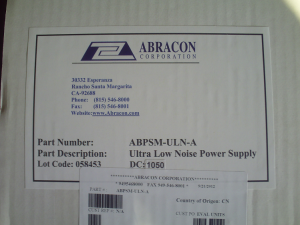
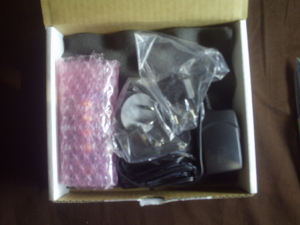
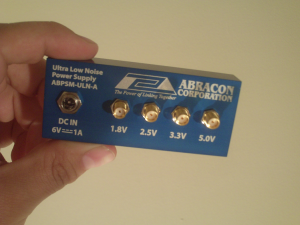
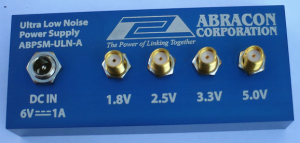
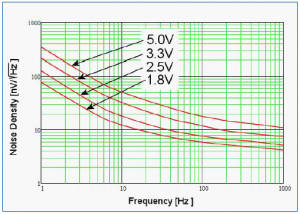
Review: Abracon ABFT Frequency Translators | KF5OBS /IP
[…] that’s enough text for now. It’s time to look at some pictures. I used the ABPSM-ULN-A ultra low noise power supply module and the Abracon Sync ‘n Go together with the ABFT eval board in my test setup. My test […]
David
Hmmm… This thing looks like an expensive thing to solve a simple solution. For the lowest noise supply, why can’t we use a simple battery instead? A battery is completely removed from the likes of mains switching to DC converter that comes with this kit? If a regulator is required after the battery, there are some impressive low 1/F noise linear/LDO regulators out there – but a direct battery connection may be optimal?